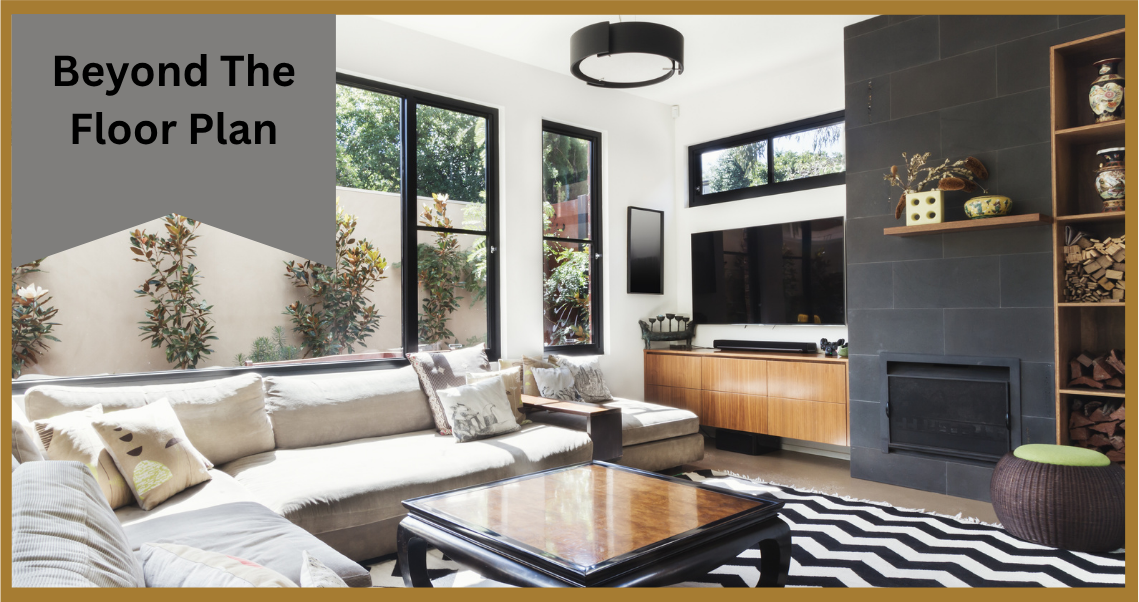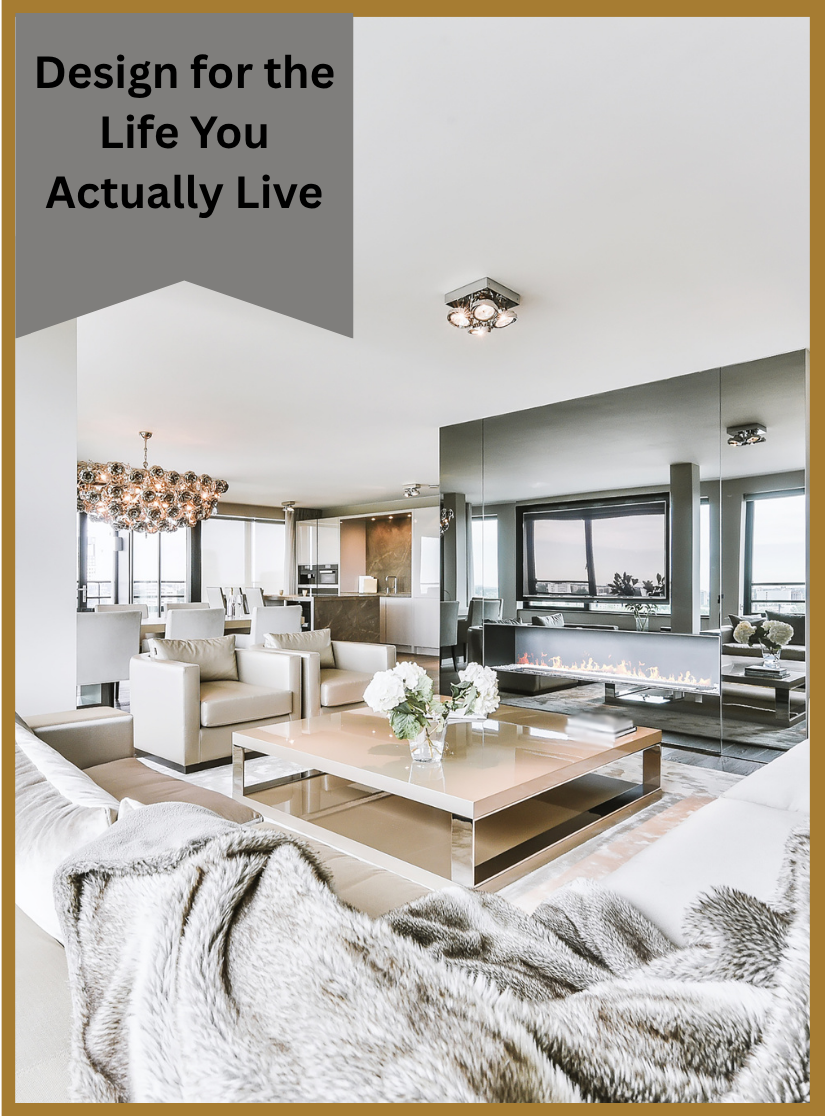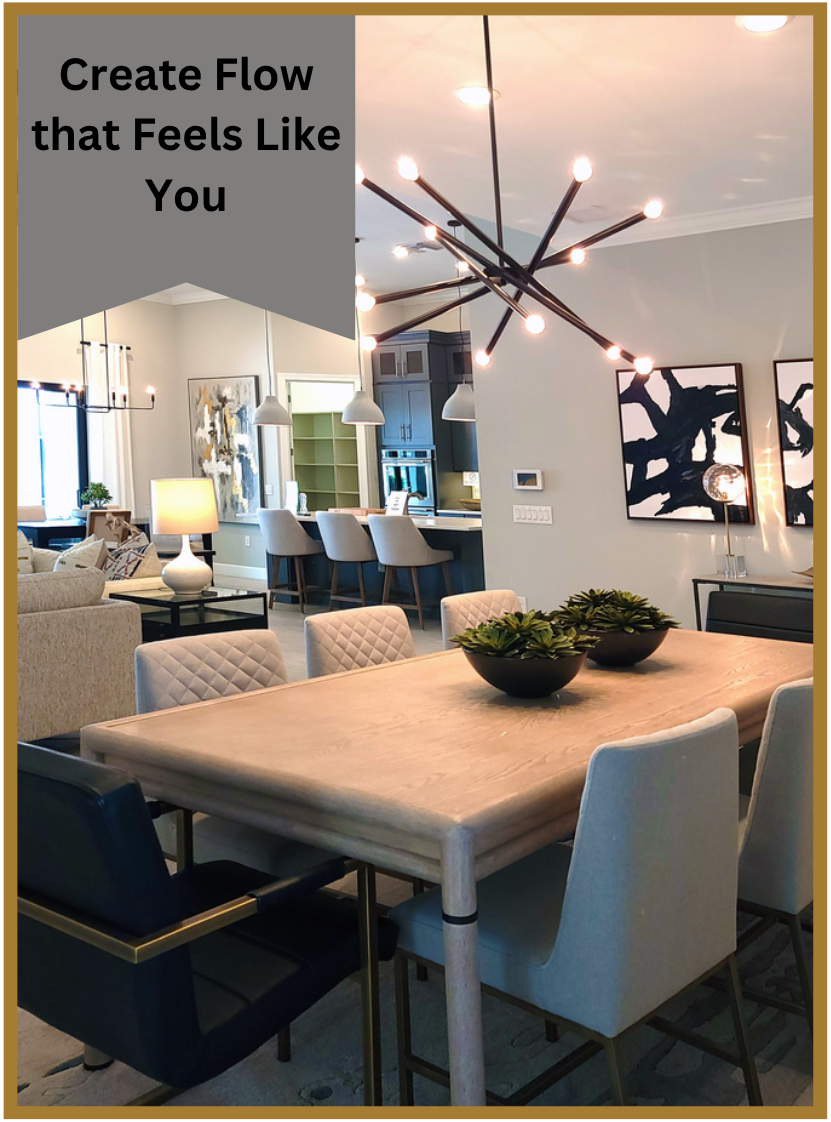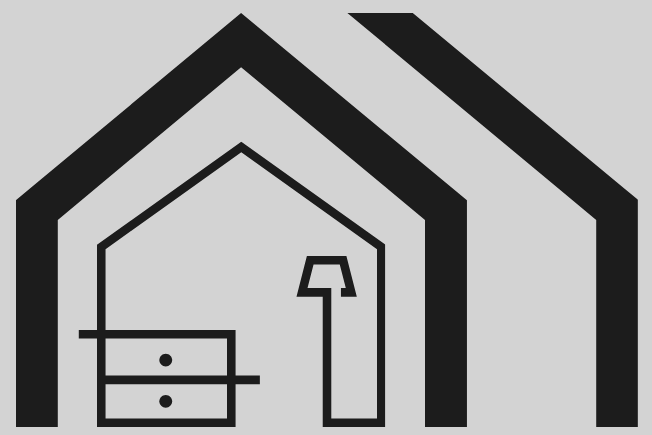Beyond The Floor Plan: Designing for How You Really Live
Why do I still feel frustrated in my re-designed room that is supposed to be “done”?
If you have ever looked around a fully decorated room and thought,
“Why does this still not feel right?” , you are not alone. More and more, the conversation around design is shifting. We are moving beyond aesthetics and into something deeper: livability. Today’s design magazines, blogs, and DIY forums are filled with homeowners asking the same question, not just how to make a space look beautiful, but how to make it work. This idea, designing for how you really live, has been a core focus of mine for years, and it is something I stress with every client I work with. Let us go beyond the surface and explore what might actually be missing.
When a home is functioning well, you do not have to think about it, it just works!
That is the quiet power of good space planning. You move through your day with ease. Nothing feels out of place or in the way. You are not constantly wondering where to store something, how to hide clutter, or how to adjust your routine to fit around your home’s limitations. Instead, your home quietly supports you. It flexes and adapts to your rhythms, your habits, your people, and your pace of life.
Function shows up in the smallest, most ordinary moments. It is the hook by the back door that holds your coat when your hands are full. It is the depth of your kitchen counters and whether there is space to cook while helping with homework. It is the landing spot for your keys, the drawer where chargers live, the room where you retreat to reset. These may seem like small details, but they shape how you feel in your space. When they are overlooked, they add stress. When they are thoughtfully planned, life flows more easily, and your home becomes more than just a pretty space. It becomes a tool that works for you.
This is where intentional design begins: by paying attention to what your daily life actually looks like. Not just the special moments, but the real, repetitive ones. The drop zone, the mail pile, the shoes, the grocery bags, the backpacks, the dog leash. If you want a space that feels peaceful, organized, and livable, you have to design it with these real-life details in mind.
Form Follows Function: Why It Matters More Than Ever
The phrase form follows function is more than just design philosophy, it is a guiding truth. It means that how a space functions should determine how it looks, not the other way around. While aesthetics absolutely matter, they should never come at the expense of usability. When we design with function first, beauty becomes more meaningful, because it is not just decorative, it is supportive.
Think of your home as a living system. Each room, each corner, each piece should serve a purpose, even if that purpose is simply to create peace. The way you move through a space, where you enter, where you drop your keys, where you rest, recharge, or connect, should shape how that space is built and styled. When a room is designed around your real life, everything has its place. The furniture feels intuitive. The flow makes sense. You do not have to work around the space, it works for you.
Form follows function also helps avoid costly mistakes. A sofa that looks great in a showroom may not be the right scale for your room. A dramatic pendant light might draw attention, but if it does not illuminate the right task zone, it fails. Even paint color, window treatments, and storage must all serve the lifestyle you are actually living, not just the one on Pinterest.
As a designer, I see it time and again: when clients prioritize how they live, the design falls into place more naturally. The colors feel more authentic. The layout supports real movement. And the space tells their story, not someone else’s idea of it.
Before choosing what something should look like, ask: what does it need to do?
That is the heart of intentional design. That is how form can finally follow function, and why your home will not just look good, but feel right.
Design for the Life You Actually Live
And here is the designer insight I always share first: be honest with yourself.
If you struggle with organization, if you are naturally messy, or if you live with someone who is, do not design around an idealized version of your habits. Design around your actual rhythms, behaviors, and needs. This is not about settling, it is about creating solutions that truly serve you. Your home should not be aspirational in a way that makes you feel like you are always falling short. It should be aspirational in the sense that it helps you function better, feel better, and live better.
One of the biggest mistakes I see is designing a space based on how someone wants to live, rather than how they actually live. That beautiful open shelf system might look great in a catalog, but if you hate visual clutter or never have time to style it, it will drive you crazy. A white sofa might be gorgeous, but if you have pets, young kids, or movie nights with red wine and popcorn, it might not be the wisest choice. Your design should reflect your reality, not someone else’s fantasy.
This is not about judgment, it is about awareness. I tell my clients all the time: your home is not just where life happens, it is the tool that helps you live it better. A well-designed space can help you create better habits. It can encourage more rest, more connection, more order, and even more creativity. My job is not to impose a standard, it is to listen, reflect, and design with compassion and clarity.
The more honest you are at the beginning, the better the outcome will be. Design with self-awareness, and your home becomes not just beautiful, but beautifully supportive.
Create Flow That Feels Like You
Create zones that promote connection, reading corners that invite you to pause, conversation clusters that bring people together, and open walkways that guide the eye and body naturally through the space. These are not just stylistic choices, they are foundational to how well a room functions.
This is the heart of functional design: a space that moves with you, not against you.
When a space flows, life does too. You find yourself reaching for what you need without thinking. You rest more easily, entertain more effortlessly, and feel more at peace in your home. That is the quiet power of good design, it removes friction and adds ease.
Designing beyond the floor plan means looking deeper than measurements and materials. It means considering your morning routines, your messy drop zones, your favorite chair by the window, and even the way your family naturally gathers after dinner. Those are the real moments that deserve thoughtful design.
Your home should not just look beautiful, it should feel intuitive. And when it does, you will know it. You will move through your space without resistance. Your home will support your habits, your quirks, and your aspirations. That is the beauty of designing for how you really live.
Because the most successful spaces are not always the most glamorous ones, they are the ones that feel like home.
Tina Wright launched The Design Journal in 2024 as a space to share expert insights, timeless design principles, and practical tips for creating beautiful functional homes. In 2025 she expanded her reach by writing, a monthly local newspaper column, offering readers a deeper dive into the art of interior design. As the owner and principal designer of Fine Interiors of WNC, Tina brings over 25 years of experience to her work, transforming homes across the Southeastern U.S. with her client-focused approach and passion for design. Whether through her newspaper column, blog, or one-on-one consultation, she is dedicated to helping homeowners make timeless, thoughtful, design choices.
Frequently Asked Questions:
FAQ: Why does my room look beautiful but still feel “off”?
Answer: Because more than likely function is missing. A space can be styled to perfection but still fall short if it does not support your actual lifestyle. True design goes beyond aesthetics, it addresses how you live, move, gather, and relax. If your space feels awkward, it is often a sign that the layout, flow, or purpose of the room is not in sync with your daily habits.
FAQ: What does “form follows function” really mean in home design?
Answer: It means that beauty should emerge from usefulness. In other words, the layout, furnishings, and features of a room should be based on what you actually need and how you live, not just what looks good in a photo. When design decisions prioritize functionality first, the result is a space that not only looks great but works effortlessly for your life.
FAQ: What should I do if I live with someone who has a different lifestyle or habits than I do?
Answer: Design should reflect everyone who lives in the home. That might mean creating flexible zones, such as a family room that accommodates quiet time and movie nights, or using furnishings like swivel chairs and movable lighting to help shift the focus based on different needs. Good space planning creates harmony between people, not just between furniture pieces.
FAQ: How do I design a space that supports better habits?
Answer: Start by being honest about how you live, not how you wish you lived. If you tend to accumulate clutter near the entryway, design a drop zone with storage that fits your rhythm. If you read every evening, carve out a reading corner with good light and cozy seating. The key is to build your space around your real routines, then layer beauty on top.
FAQ: Where should I begin if I want my home to “flow” better?
Answer: Begin with traffic patterns and zoning. Observe how you and your family naturally move through the space. Are you constantly bumping into furniture? Do you avoid certain areas because they feel cramped or awkward? Start by rearranging furniture to encourage smoother movement, then define specific zones for activities like reading, dining, or conversation. Even small changes can dramatically improve how your space feels.
We Would Love to Hear From You!
Have you ever faced a design challenge in your home, big or small, and found a creative solution that worked for you? Whether it was a clever layout tweak, a bold color choice, or a DIY fix that made all the difference, your experience might inspire someone else. Feel free to share with me, send photos to Tina at fineinteriors@msn.com. I always enjoy hearing from readers and clients, it’s how the best design conversations begin.







